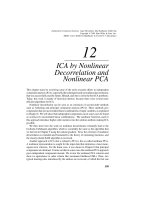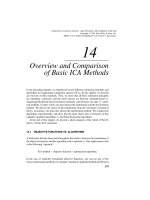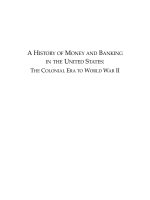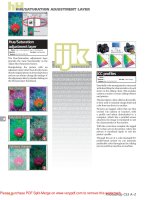Tài liệu Air pollution removal by urban trees and shrubs in the United States pptx
Bạn đang xem bản rút gọn của tài liệu. Xem và tải ngay bản đầy đủ của tài liệu tại đây (970.43 KB, 9 trang )
Available
online
at
www.sciencedirect.com
Urban Forestry
&
Urban Greening
4 (2006) 11 5-123
Air pollution removal by urban trees and shrubs in the United States
David
J.
~owak*, Daniel
E.
Crane, Jack C. Stevens
USDA Forest Service, Nortlzeastem Research Station,
5
~Woorz Library, S
LIIV
Y-ESF, Sj~rczmse,
N
Y
1321
0
USA
Abstract
A modeling study using hourly meteorological and pollution concentration data from across the coterminous
United States demonstrates that urban trees remove large amounts of air pollution that consequently irnprove urban
air quality. Pollution removal
(03, PMio, NO2, SO2, CO) varied among cities with total annual air pollution removal
by US urban trees estimated at 71 1,000 metric tons ($3.8 billion value). Pollution removal is only one of various ways
that urban trees affect air quality. Integrated studies of tree effects on air pollution reveal that management of urban
tree canopy cover could be a viable strategy to improve air quality and help meet clean air standards.
Published by
Elsevier GmbH.
Keywords:
Air quality; Urban forests; Urban forestry; Environmental quality
1.
Introduction
Air pollution is a major environmental concern in
most major cities across the world. An important focus
of research has been on the role of urban vegetation in
the formation and degradation of air pollutants in cities.
Through the emission of volatile organic compounds
(VOC), urban trees can contribute to the formation of
ozone
(03) (Chameides et al., 1988). However, more
integrative studies are revealing that urban trees,
particularly low VOC emitting species, can be a viable
strategy to help reduce urban ozone levels (Cardelino
and Chameides, 1990; Taha, 1996; Nowak et
a]., 2000),
particularly through tree functions that reduce air
temperatures (transpiration), remove air pollutants
(dry deposition to plant surfaces), and reduce building
energy and consequent power plant emissions
(e.g.,
temperature reductions; tree shade). One study (Nowak
et al.,
2000) has concluded that for the US northeast
*~orresponditlg author. Tel.:
+
1
3 15 448 321 2:
fax:
+-
13154483216.
E-mtli/
ucicilress:
dn0wakgfs.fed.u~
(D.J.
Nowak).
coast, the physical effects of urban trees were more
important than the chemical effects in terms of affecting
ozone concentrations.
Nationally, urban trees and shrubs (hereafter referred
to collectively as "trees") offer the ability to remove
significant amounts of air pollutants and consequently
improve environmental quality and human health. Trees
remove gaseous air pollution primarily by uptake via
leaf stomata, though some gases are removed by the
plant surface. Once inside the leaf, gases diffuse into
intercellular spaces and may be absorbed by water films
to form acids or react with inner-leaf surfaces (Smith,
1990). Trees also remove pollution by intercepting
airborne particles. Some particles can be absorbed into
the tree, though most particles that are intercepted are
retained on the plant surface. The intercepted particle
often is resuspended to the atmosphere, washed off by
rain, or dropped to the ground with leaf and twig
fall.
Consequently, vegetation is only a ternporary retention
site for many atmospheric particles.
To investigate the magnitude of air pollution removal
by urban trees throughout the lower
48
United States,
computer modeling of air pollution removal of carbon
161 8-8667/$
-
see front matter Published by Elsevier GmbH.
doi:
10.1016/j.ufug.2006.01.007
116
D.J.
Nowak et al.
/
Urban Forestry
&
Urban Greening
4
(2006)
115-123
monoxide (CO), nitrogen dioxide (NO2), ozone, parti-
culate matter less than 10
pm (PMlo) and sulfur dioxide
(SOz) was performed for 55 US cities and for the entire
nation based on meteorological, pollution concentra-
tion, and urban tree cover data. Due to the need for
various assumptions within the model, the model
provides a first-order estimate of the magnitude of
pollution removal by urban trees.
Methods
For each city, the downward pollutant flux
(I;;
in
gm-2s-') was calculated as the product of the deposi-
tion velocity
(Vd; in m s-') and the pollutant concentra-
tion
(C; in gm-3)
(F=
VdO. Deposition velocity was
calculated as the inverse of the sum of the aerodynamic
(R,), quasi-laminar boundary layer
(Rb) and canopy
(&)
resistances (Baldocchi et al., 1987). Hourly esti-
mates of
R, and Rb were calculated using standard
resistance formulas
(Killus et al., 1984; Pederson et al.,
1995; Nowak et al., 1998) and hourly weather data from
nearby airports for 1994.
R,
and Rb effects were
relatively small compared to
R,
effects.
Hourly canopy resistance values for
03, SO2, and
NO2 were calculated based on a modified hybrid of big-
leaf and multilayer canopy deposition models (Baldoc-
chi et al., 1987; Baldocchi, 1988). Canopy resistance
(&)
has three components: stomata1 resistance (r,), meso-
phyll resistance (r,), and cuticular resistance (rt), such
that: 1/&
=
l/(r,
+
r,)
-t
1
/r,. Mesophyll resistance was
set to zero
s m-' for SO2 (Wesely, 1989) and 10 s m' for
O3 (Hosker and Lindberg, 1982). Mesophyll resistance
was set to
100sm-' for NO2 to account for the
difference between transport of water and
NO2 in the
leaf interior, and to bring the computed deposition
velocities in the range typically exhibited for
NO2
(Lovett, 1994). Base cuticular resistances were set at
8000sm-' for SOz, 10,000 sm-' for 03, and
20,000
s m-' for NO2 to account for the typical variation
in
r, exhibited among the pollutants (Lovett, 1994).
As removal of CO and particulate matter by
vegetation are not directly related to photosynthesis/
transpiration,
&
for CO was set to a constant for
in-leaf season (50,000
s m-') and leaf-off season
(1,000,000
s
rn-l)
(Bidwell and Fraser, 1972). For
particles, the median deposition velocity (Lovett, 1994)
was set to 0.064
rn
s-I based on 50-percent resuspension
rate (Zinke, 1967). The base Vd was adjusted according
to in-leaf
vs. leaf-off season parameters. To limit
deposition estimates to periods of dry deposition,
deposition velocities were set to zero during periods of
precipitation.
Each city was assumed to have a single-sided leaf area
index within the canopy covered area of 6 and to be
10% coniferous (Nowak, 1994). Leaf area index value is
total leaf area (m2: trees and large shrubs [minimum 1 in
stem diameter]) divided by total canopy cover in city
(m2) and includes layering of canopies. Regional leaf-on
and leaf-off dates were used to account for seasonal leaf
area variation. Total tree canopy cover in each city was
based on aerial photograph sampling (Nowak et al.,
1996) or advanced very high resolution radiometer data
(Dwyer et al., 2000; Nowak et al., 2001).
Hourly pollution concentration data (1994) from each
city were obtained from the US Environmental Protec-
tion Agency (EPA). Missing hourly meteorological or
pollution-concentration data were estimated using the
monthly average for the specific hour. In some locations,
an entire month of pollution-concentration data may be
missing and are estimated based on interpolations from
existing data. For example,
O3 concentrations may not
be measured during winter months and existing
03
concentration data are extrapolated to rnissing months
based on the average national
O3
concentration monthly
pattern. Data from 1994 were used due to available data
sets with cloud cover information. To estimate percent
air quality improvement due to dry deposition (Nowak
et al.,
2000), hourly boundary heights were used in
conjunction with local deposition velocities for select
cities with boundary layer height data. Daily morning
and afternoon mixing heights from nearby stations were
interpolated to produce hourly values using the
EPA's
PCRAMMIT program (US EPA, 1995). Minimum
boundary-layer heights were set to 150 m during the
night and 250m during the day based on estimated
minimum boundary-layer heights in cities. Hourly
mixing heights (m) were used in conjunction with
pollution concentrations
(pg m-3) to calculate the
amount of pollution within the mixing layer
(pg mA2).
This extrapolation from ground-layer concentration to
total pollution within the boundary layer assumes a
well-mixed boundary layer, which is common in the
daytime (unstable conditions) (Colbeck and Harrison,
1985). Hourly percent air quality improvement was
calculated as grams
removed/(grams removed
-t
grams
in atmosphere), where grams in atmosphere
=
measured
concentration (g
mm3)
x
boundary layer height (m)
x
city area (m2).
To estimate pollution removal by all urban trees in
the United States, national pollution concentration data
(all EPA monitors) were combined with standardized
local or regional pollution removal rates. Pollution
removal rates
(gm-2 of tree cover) standardized to the
average pollutant concentration in the city
(gm-2 per
ppm or per
pgmm3). As flux rates are directly propor-
tional to pollutant concentrations, standardized removal
rates are used to account for concentration differences
among urban areas.
For all urban areas in the United States outside of the
55 analyzed cities, local pollution monitoring data were
D.J.
Nowak
et
al.
,
Urban Forestry
&
Urban Greenlng
4
(2006)
115-123 117
used to calculate the average pollution concentration in
the urban area for each pollutant. Urban area bound-
aries are based on 1990 census definitions of urbanized
areas (areas with population density
z
1000 people
mi-') and urban places (incorporated or unincorporated
(census-defined) places with a population
>
2500)
outside of urbanized areas. If pollutant monitors did
not exist within the urban area, minimum state pollution
concentration data were assigned to the urban area.
Likewise, standardized pollution removal rates were
assigned to each urban area based on data from the
closest analyzed city within the same climate zone.
All
urban areas within a state were assigned to the dominant
climate zone (coo1 temperate, Desert, Mediterranean,
steppe, tropical, tundra, warm temperate) in the state,
except for California and Texas where urban areas were
individually assigned to one of multiple state climate
zones.
For each urban area exclusive of the 55 analyzed
cities, standardized pollution removal rates were multi-
plied by average pollutant concentration and total
amount of tree cover to calculate total pollution
removal for each pollutant in every urban area. Urban
area pollution removal totals were combined to estimate
the national total. Pollution removal value
was
estimated using national median externality values
(Murray et al 1994). Values were based on the
median monetized dollar per ton externality values
used in energy-decision-making from various studies.
These values, in dollars per metric ton (t) are:
NO2
=
$6752 t-*, PMlo
=
$4508 t-l, SO2
=
$1653 t-l,
and CO
=
$959 t'. Externality values for O3 were set to
equal the value for
NO2. Externality values can be
considered the estimated cost of pollution to society that
is not accounted for in the market price of the goods or
services that produced the pollution.
Results and discussion
Total pollution removal and value varied among the
cities from 1 1,100 t
a-' ($60.7 million a-') in Jackson-
ville, FL to 22
ta-I
($1
16,000a-') in Bridgeport, CT
(Table 1). Pollution removal values per unit canopy
cover varied from 23.1
g m-' a-' in Los Angeles, CA to
6.2gmW2a-' in Minneapolis,
MN.
The median pollu-
tion removal value per unit canopy cover was
10.8gm-~a-'.
Pollution removal values for each pollutant will vary
among cities based on the amount of tree cover
(increased tree cover leading to greater total removal),
pollution concentration (increased concentration lead-
ing to greater downward flux and total removal), length
of in-leaf season (increased growing season length
leading to greater total removal), amount of precipita-
tion (increased precipitation leading to reduced total
removal via dry deposition), and other meteorological
variables that affect tree transpiration and deposition
velocities (factors leading to
increased
deposition
velocities
would lead to greater downward flux and
total removal). All of these factors combine to affect
total pollution removal and the standard pollution
removal rate per unit tree cover,
Jacksonville's urban forest had the largest total
removal, but had below median value of pollution
removal per unit tree cover. Jacksonville's high total
pollution removal value was due to its large city size
(1
965 km') and relatively high estimated percent tree
cover within the city
(53%). Los Angeles had the highest
pollution removal values per unit tree cover due to its
relatively long in-leaf season, relatively low precipita-
tion, and relatively high pollutant concentrations and
deposition velocities. Minneapolis had the lowest pollu-
tion removal values per unit tree cover due, in part, to its
relatively short in-leaf season.
Average leaf-on daytime dry deposition velocities
varied among the cities ranging from 0.44 to 0.29 cm
s-'
for NO', 0.40 to 0.71 cms-' for 03, and 0.38 to
0.69 cm
s-' for SO2. Deposition velocities did not vary
for CO and
PMlo as deposition rates for these pollutants
were not related to transpiration rates, but rates did vary
based on leaf-off
ahd leaf-on seasons. The deposition
velocities for CO and
PMlo were based on literature
averages and assumed to be constant. The highest
deposition velocities occurred in San Jose, CA; the
lowest in Phoenix, AZ.
Though urban trees remove tons of air pollutants
annually, average percent air quality improvement in
cities during the daytime of the vegetation in-leaf season
were typically less than
1
percent (Table 2) and varied
among pollutants based on local meteorological and
pollution concentration conditions. Percent air quality
improvement was typically greatest for particulate
matter, ozone, and sulfur dioxide. Air quality improve-
ment increases with increased percent tree cover and
decreased mixing-layer heights.
In urban areas with
100% tree cover
(i.e., contiguous forest stands), average
air quality improvements during the daytime of the
in-
leaf season were around two percent for particulate
matter, ozone, and sulfur dioxide. In some cities, short-
term air quality improvements (one hour) in areas with
100% tree cover are estimated to be as high as
16%
for
ozone and sulfur dioxide, 9% for nitrogen dioxide, 8%
for particulate matter, and 0.03% for carbon monoxide
(Table 2).
These estimates of air quality improvement due to
pollution removal likely underestimate the total effect of
the forest on reducing ground-level pollutants because
they do not account for the effect of the forest canopy in
preventing concentrations of upper air pollution from
reaching ground-level air space. Measured differences in
Table
1.
Annual pollution removal
(1994)
by
trees and associated value in
55
US
cities
City
Total
Albany,
NY"
Albuquerque,
NM~
Atlanta, GA
Austin, TX
Baltimore, MD
Baton Rouge, LA
Boston,
MA
Bridgeport, CT
Buffalo,
NY
Charleston,
WV
Cincinnati, OH
Cleveland, OH
Columbia, SC
Columbus, OHC
Dallas, TX
Denver, CO
Detroit, MI
El
Paso, TX
Fresno, CA
Honolulu, HI
Houston, TX
Indianapolis,
IN
Table
1.
(co~ttii~~~?cf)
City
0
1
PM
lo
NO2 SO2 CO Total
(t)
(gm-2)
(t)
(gm
2,
0)
(gm-2)
(1)
(gm
-')
(t)
(gin
'1
(t)
@m-")
(($
x
1000)
Jacksonville, FL
Jersey City,
NJ~
Kansas City, MC)
Los Angeles, CA
Louisville, KY
Me~nphts, TN
Miami, FL
Milwaukee,
WI
Minneapolis. MN
Nashville, TN
New Orleans, LA
New York,
NY
Newark, NJ
Oklahoma OK
Omaha, NE"
Philadelphia, PA
Phoenix, AZ
Pittsburgh, PA
Portland,
OR
Providence,
RI
Roanoke,
VA
Sacramento. CA
Table
1.
(con
tinuecl)
City
03
I'M lo No2
so2
CO Total
(t) (sm-2) (t) (gm-2) 0) (sm-2> (t) (gm-" (0 (gm-
2,
(t)
($
x
1000)
Salt Lake City, UT
T
R
San
Diego, CA T
R
San Francisco, CA T
R
San Jose,
CA'
T
R
Seattle, WAg T
R
St. Louis, MO T
R
Tampa, FL T
R
Tucson, AZ T
R
Tulsa, OK T
R
Virginia Beach-Norfolk, VA T
R
Washington, DC T
R
Total
(T) and range (R) are given in metric tons (t) and in grams per square meter of canopy cover (g m-2) for ozone (03),
r
less
than 10 pm (PM,~), nitrogen dioxide (NO2), sulfur
dioxide (SO2), and carbon monoxide (CO). The monetary value of pollution removal by trees is estimated using the median externality values for the United States for each pollutant (Murray et al.,
1994). Bounds of total tree
removal of
03,
NO2, SO2, and PMIo were estimated using the typical range of published in-leaf dry deposition velocities (Lovett, 1994).
"NO2 data from Buffalo,
NY
'so2
data from
El
Paso, TX
'NO2 data from Cincinnati, OH
d~eather data from Newark, NJ
"NO2 data from Kansas City, MO
f~eather data froin San Francisco, CA
gN02 data from Portland, OR
h
ti,
W
w
D.J.
Nowak et al.
/
Urban Forestry
&
Urban Greening
4
(2006) 115-123
121
Table
2.
Estimated percent air quality improvement
in
selected US cities due to air pollution removal by urban trees
City %tree cover
%
air quality improvement
Atlanta, GA
Boston,
MA
Dallas, TX
Denver,
CO
Milwaukee, WI
New York, NY
Portland,
OR
San Diego, CA
Tampa,
FL
Tucson,
AZ
Washington,
DC
Estimates are given for actual tree cover conditions in city for ozone (a3), particulate matter less than 10 pm (PMlo), nitrogen dioxide (NO2), sulfur
dioxide
(SO2), and carbon monoxide (CO) based on local boundary layer height and pollution removal estimates. Bounds of total tree removal of 03,
NO2, SO2, and PMlo were estimated using the typical range of published in-leaf dry deposition velocities (Lovett, 1994)
O3 concentration between above- and below-forest
canopies in California's San Bernardino Mountains
have exceeded 50 ppb (40-percent improvement)
(By-
tnerowicz et al., 1999). Under normal daytime condi-
tions, atmospheric turbulence mixes the atmosphere
such that pollutant concentrations are relatively con-
sistent with height (Colbeck and Harrison, 1985). Forest
canopies can limit the mixing of upper air with
ground-
level air, leading to significant below-canopy air quality
improvements. However, where there are numerous
pollutant sources below the canopy
(e.g., automobiles),
the forest canopy could have the inverse effect by
minimizing the dispersion of the pollutants away at
ground level.
The greatest effect of urban trees on ozone, sulfur
dioxide, and nitrogen dioxide is during the daytime of
the in-leaf season when trees are transpiring water.
Particulate matter removal occurs both day and night
and throughout the year as particles are intercepted by
leaf and bark surfaces. Carbon monoxide removal also
occurs both day and night of the in-leaf season, but at
much lower rates than for the other pollutants.
Urban areas are estimated to occupy 3.5% of lower 48
states with an average canopy cover of
27%.
Urban tree
cover varies by region within the United States with
cities developed in forest areas averaging 34.4% tree
cover, cities in grassland areas:
17.8%, and cities in
deserts: 9.3%
(Dwyer et al., 2000; Nowak et al., 2001).
Total pollution air removal (5 pollutants) by urban trees
in coterminous United States is estimated at 71 1,000 t,
with an annual value of $3.8 billion (Table 3).
Though the estimates given in this paper are only for a
1-year period
(1994), analysis of changes in meteorology
and pollution concentration on pollution removal by
urban trees over a 5-year period in Chicago (1 99 1-1995)
reveals that annual removal estimates were within 10%
of the 5-year average removal rate. Estimates of
pollution removal may be conservative as some of the
deposition-modeling algorithms are based on homo-
genous canopies. As part of the urban tree canopy is
heterogeneous with small patches or individual trees,
this mixed canopy effect would tend to increase
pollutant deposition. Also, aerodynamic resistance
estimates may be conservative and lead to a slight
underestimate of pollution deposition.
Though the average percent air quality improvement
due to trees is relatively low
(<
1
%),
the improvement is
for multiple pollutants and the actual magnitude of
pollution removal can be significant (typically hundreds
to thousands of metric tons of pollutants per city per
122
D.J.
Nowak et al.
/
Urban Forestry
&
Urban Greening
4
(2006) 115-123
Table
3.
Air pollution removal and value for all urban trees
provide a viable means to improve air quality and help
in the coterminous United States
meet clean air standards in the United States.
Pollutant Removal (t) Value
($
x
lo6)
Total 71 1,300 3828
(256,600-978,800) (1,249-5
1 58)
Estimates are given for ozone
(03),
particulate matter less than
10
pm
(PMlo), nitrogen dioxide
(NOz),
sulfur dioxide
(SO2),
and carbon
monoxide
(CO).
The monetary value of pollution removal by trees is
estimated using the median externality values for the United States for
each pollutant (Murray et al.,
1994).
Externality values for
O3
were set
to equal the
value for
NOz.
Bounds of total tree removal of
03.
NOz,
SOz,
and PMlo were estimated using the typical range of published in-
leaf dry deposition velocities (Lovett,
1994).
year). Percent air quality improvement estimates are
likely conservative and can be increased through
programs to increase canopy cover within cities. Air
pollution removal is also only one aspect of how urban
trees affect air quality. Ozone studies that integrate
temperature, deposition and emission effects of trees are
revealing that urban trees can have significant effects on
reducing ozone concentrations (Cardelino and
Cha-
meides, 1990; Taha, 1996; Nowak et al., 2000). Based in
part on these findings, the US Environmental Protection
Agency has introduced urban tree cover as a potential
emerging measure to help meet air quality standards
(US EPA, 2004). So even though the percent air quality
improvement from pollution removal by trees may be
relatively
small, the total effect of trees on air pollution
can produce impacts that are
significant enough to
warrant consideration of tree cover management as
a
means to improve air quality.
Conclusion
Through pollution removal and other tree functions
(e.g., air temperature reductions), urban trees can help
improve air quality for many different air pollutants in
cities, and consequently can help improve human health.
While the existing percent air quality improvements due
to pollution removal by urban trees are modest, they can
be improved by increasing urban tree canopy cover. The
combined total effects of trees on air pollutants are
significant enough that urban tree management could
Acknowledgments
This work was supported by funds through the
USDA Forest Service's RPA Assessment Staff, and
State and Private Forestry's, Urban and Community
Forestry Program. We thank D. Baldocchi,
M. Ibarra,
E.L.
Maxwell, and
M.H.
Noble for assistance with
model development and data processing.
References
Baldocchi, D., 1988. A multi-layer model for estimating sulfur
dioxide deposition to a deciduous oak forest canopy.
Atmospheric Environment 22, 869-884.
Baldocchi, D.D., Hicks, B.B., Camara, P., 1987. A canopy
stomata1 resistance model for gaseous deposition to
vegetated surfaces. Atmospheric Environment 2
1,
9
1-1
0 1.
Bidwell, R.G.S., Fraser, D.E., 1972. Carbon monoxide uptake
and metabolism by leaves. Canadian Journal of Botany 50,
1435-1439.
Bytnerowicz.
A,. Fenn, M.E Miller, P.R Arbaugh, M.J.,
1999. Wet and dry pollutant deposition to the mixed conifer
forest. In: Miller, P.R.,
McBride, J.R. (Eds.), Oxidant Air
Pollution Impacts in the Montane Forests of Southern
California: A Case Study of the San Bernardino Moun-
tains. Springer, New York, pp. 235-269.
Cardelino,
C.
A., Chameides, W.
L.,
1
990. Natural hydrocar-
bons, urbanization, and urban ozone. Journal of Geophy-
sical Research 95
(D9), 13,971-1 3,979.
Chameides, W.L., Lindsay, R.W Richardson,
J.,
Kiang, C.S.,
1988. The role of biogenic hydrocarbons in urban photo-
chemical smog: Atlanta as a case study. Science 241, 1473.
Colbeck,
I.,
Harrison, R.M., 1985. Dry deposition of ozone:
some measurements of deposition velocity and of vertical
profiles to 100 metres. Atmospheric Environment 19
(1
1).
1807-1818.
Dwyer.
J.F., Nowak, D.J., Noble, M.H., Sisinni, S.M., 2000.
Assessing our nation's urban forests: connecting people
with ecosystems in the
21st century. USDA Forest Service
General Technical Report PNW-460, Portland, OR.
Hosker, R.P., Lindberg, S.E., 1982. Review: atmospheric
deposition and plant assimilation of gases and particles.
Atmospheric Environment 16
(5), 889-9 10.
Killus, J.P., Meyer, J.P., Durran, D.R., Anderson, G.E.,
Jerskey, T.N., Reynolds, S.D., Ames, J., 1984. Continued
Research in Mesoscale Air Pollution Simulation Modeling,
Vol.
V:
refinements in numerical analysis. transport,
chemistry, and pollutant removal,
EPAi600/3-84,'095a.
US EPA, Research Triangle Park. NC.
Lovett,
G.M
.,
1994. Atmospheric deposition of nutrients and
pollutants in North America: an ecological perspective.
Ecological Applications 4, 629-650.
Murray, F.J., Marsh, L., Bradford, P.A., 1994. New York
State Energy Plan, vol.
11: Issue Reports. New York State
Energy Office, Albany, NY.
D.J.
Nowak et al.
/
Urban Forestry
&
Urban Greening
4
(2006)
115-123 123
Nowak, D.J., 1994. Air pollution removal by Chicago's urban
forest. In:
McPherson, E.G., Nowak, D.J., Rowntree, R.A.
(Eds.), Chicago's Urban Forest Ecosystem: Results of the
Chicago Urban Forest Climate Project. USDA Forest
Service General Technical Report NE- 186, Radnor, PA,
pp. 63-81.
Nowak,
D.J., Rowntree, R.A., McPherson, E,G,, Sisinni,
S.M., Kerkmann, E., Stevens, J.C., 1996. Measuring and
analyzing urban tree cover. Landscape and Urban Planning
36,49-57.
Nowak, D,J,, McWale,
P.J.,
Ibarra,
M.,
Crane, D., Stevens,
J.,
Luley, C,, 1998, Modeling the effects of urban vegetation
on air pollution, In: Gryning,
S.E., Chaumerliac, N. (Eds.),
Air Pollution Modeling and its Application XII. Plenum
Press, New York, pp.
399-407.
Nowak, D.J., Civerolo, K.L., Rao, ST., Sistla, G., Luley, C.J.,
Crane, D.E.,
2000. A modeling study of the impact of urban
trees on ozone. Atmospheric Environment 34, 1610-1 61 3.
Nowak, D.J., Noble, M.H., Sisinni, S.M., Dwyer, J.F., 2001.
Assessing the US urban forest resource. Journal of Forestry
99
(3), 37-42.
Pederson, J.R.,
Massman, W.J., Mahrt, L., Delany, A,,
Oncley, S., den Hartog, G., Neumann, H.H., Mickle,
R.E., Shaw, R.H., Paw, UKT., Grantz, D.A.,
MacPherson,
J.I., Desjardins,
R.,
Schuepp, P.H., Pearson, R., Arcado,
T.E., 1995. California ozone deposition experiment: meth-
ods, results, and opportunities. Atmospheric Environment
29
(211, 31 15-31 32.
Smith,
W.H., 1990. Air Pollution and Forests. Springer, New
York.
Taha,
H,, 1996. Modeling impacts of increased urban
vegetation on ozone air quality in the South Coast Air
Basin, Atmospheric Environment 30
(20), 3423-3430.
US Environmental Protection Agency (US EPA), 2004.
Incorporating Emerging and Measures in a State Imple-
mentation Plan (SIP). US Environmental Protection
Agency, Research Triangle Park,
NC. .
gov/ttn/oarpg/tl/memoranda/evm~ievm~g.pdf
(last acce-
ssed: October
2005)
US Environmental Protection Agency (US EPA), 1995.
PCRAMMIT User's Guide. US Environmental Protection
Agency, Research Triangle Park, NC.
Wesely, M.L., 1989. Parameterization for surface resistance to
gaseous dry deposition in regional-scale numerical models.
Atmospheric Environment 23, 1293-1 304.
Zinke, P.J., 1967. Forest interception studies in the United
States. In:
Sopper, W.E., Lull, H.W. (Eds.), Forest
Hydrology. Pergamon Press, Oxford, pp. 137-1
6
1.









